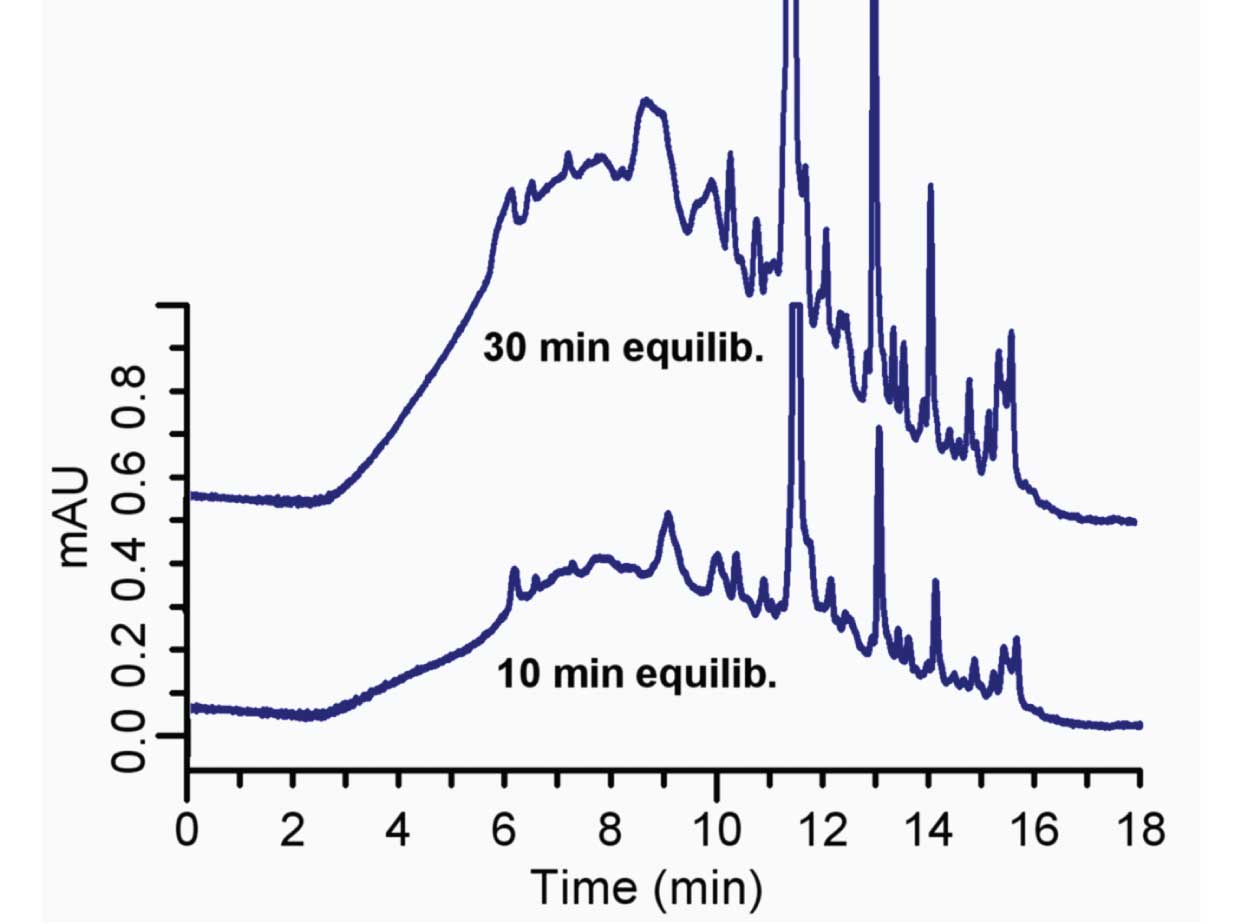If you use gradient elution for your HPLC separations, sooner or later you will run into problems with peaks that appear in the blank. Variously described as ghost peaks, background peaks or gradient interferences, these peaks can drive you crazy, especially if you are interested in measuring analytes that have small signal-to-noise ratios. Here we’re talking about peaks that show up in a no-injection, blank gradient. An example of an especially bad case of this is shown in the lower chromatogram of Figure 1. In this case, a 0.1% trifluoroacetic acid (TFA)/acetonitrile (ACN) gradient was run from 5% to 83% ACN over 13 min with a 5 min hold at the end. Although the none of the peaks are huge – the largest is just over 1 mAU in height – they were a problem for this method. These conditions were used for a stability-indicating assay that required reporting peaks of about 0.2 mAU – a real problem with this much background.
Most commonly the background peaks in gradients come from the weak solvent, which is the aqueous phase in reversed-phase separations. One way of thinking of sample behaviour in gradient elution is that sample compounds sit at the head of the column until a strong enough solvent comes along to wash them through the column. Although this description is oversimplified, it isn’t too far from the truth. The column can’t distinguish between non-polar materials that come from the sample and those that are in the mobile phase. As a result, during the initial conditions at low %B, the column tends to act as a filter for any non-polar contaminants in the mobile phase. These materials collect at the head of the column and are released when an appropriate mobile phase strength comes along. At that point, the column can’t tell the difference between junk from the mobile phase and real sample components, so they both appear as normal peaks in the gradient.
 Figure 1
Figure 1
There is a simple test to help confirm that the extra peaks originate from the A-solvent. Simply increase the equilibration time for the run and the peaks in the blank should increase proportionally. In the example of Figure 1, the normal run at the bottom used a 10 min equilibration between runs. In the upper run, the equilibration time was increased to 30 min. This had the effect of collecting three times as much junk at the top of the column before the gradient was run, resulting in peaks that are all three times as big, just as expected. This confirms that the peaks came from the A-solvent.
The next step is to further isolate the problem source by systematically removing potential sources of contamination. In the present case, the TFA was removed and the chromatogram looked different because of the absence of TFA, but many large peaks remained. The degassing technique was changed with no benefit. A different column and a different instrument were tried, to no avail. Glassware contamination was checked by rinsing glassware with organic solvent, concentrating it, and injecting it; again no contamination was found. All the tests pointed to contaminated water. When another source of water was used, most of the peaks disappeared, confirming water as the problem.
Our takeaway message from this is that it is very beneficial to run a no-injection blank gradient on a regular basis, such as part of a system suitability test, so that background peaks are recognized and can be eliminated, worked around or ignored.
This blog article series is produced in collaboration with John Dolan, best known as one of the world’s foremost HPLC troubleshooting authorities. He is also known for his research with Lloyd Snyder, which resulted in more than 100 technical publications and three books. If you have any questions about this article send them to TechTips@sepscience.com




